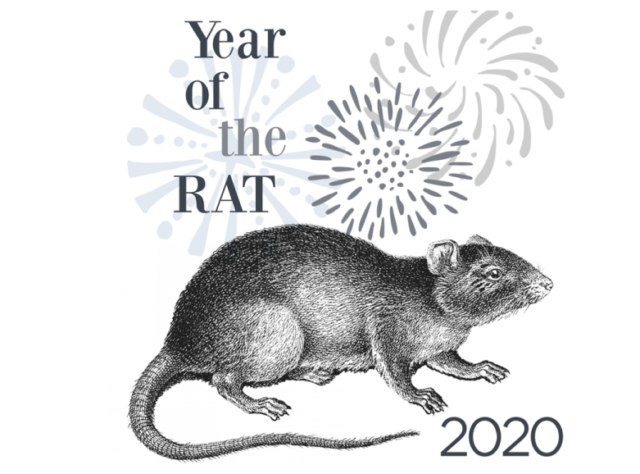
In the English language rats don’t have the best of reputations – whether it is the treacherous Peter Pettigrew in Harry Potter or selfish and mean Templeton in Charlotte’s Web.
Rats are seen as dirty, spreaders of disease and are particularly associated with the Black Death – a plague pandemic which devastated Europe from 1347 to 1352, killing an estimated 25-30 million people. It is widely believed that the disease was carried by fleas on rodents and came to Europe via Italy on Genoese trading ships. However, with more knowledge it may be that the much-maligned rat could have been wrongly scapegoated as the cause of the deadly plague. Researchers at the Universities of Oslo and Ferrara in Italy, say that it was “human fleas and body lice” that were to blame.”

Watercolour map of places where ‘The Plague’ spread in the 14th Century, by © Sean Twiddy
2020 is Year of the Rat
This is the Year of the Rat, and is the first and most prominent in the Chinese zodiac cycle. In Chinese culture rats symbolize imagination, curiosity and resourcefulness. According to one myth, the Jade Emperor said the order would be decided by the order in which they arrived at his party. The Rat tricked the Ox into giving him a ride. Then, just as they were arriving at the finishing line, Rat jumped down and landed ahead of the Ox, becoming first. In the Chinese zodiac, rats are seen as a sign of wealth and surplus. Because of their reproduction rates, married couples use to pray to them for children.
Years of the Rat: 1948, 1960, 1972, 1984, 1996, 2008, 2020
According to the Chinese horoscope, men born in the Rat year are, as their namesakes, said to be clever and adapt quickly to new environments. Grasping opportunities as they arise they are creative thinkers and are some of the best ‘ideas’ people.
Women born in the Rat year are said to be traditionalists, enjoying creating a harmonious and orderly environment ensuring everything in the home ‘has its place’.
Time to Change the Reputation of the Rat?
Rats rank somewhere between spiders and snakes when it comes to people’s heebie jeebie lists. Because not all animals are large, cute or famous, in 2012, WLT Ambassador, Simon Watt, established The Ugly Animal Preservation Society, aiming to raise the profile of some of nature’s more aesthetically challenged creatures. He believes that cute and cuddly creatures, like pandas and snow leopards, have ruled the roost for too long! He pioneers blobfishes, Proboscis Monkeys, Axolotls and vampire bats to name but a few. And a few years ago, the people of Brighton chose the Naked Mole Rat as their city’s mascot.

Naked Mole Rat. Credit: Smithsonian National Zoological Park, CC BY-NC-ND
A Remarkable Animal: the Naked Mole Rat
Many people were introduced to Naked Mole Rats through Sir David Attenborough in his Natural Curiosities TV Series. Sir David extols the virtues of this fascinating creature which is the most hairless of underground dwellers. They live in a sophisticated social structure much like that of ants and bees. Naked Mole Rats are one of only two known eusocial mammals – the colony has one breeding female (the queen), a small number of males with the rest being sterile workers. The queen produces a hormone and is extremely hostile which suppresses the workers from becoming queens. However, if the queen dies along with the hormone suppressant, a violent struggle ensues between potential new queens, until one is established.
Naked Mole Rats are extraordinary in that they can live to over 30 years old – most other rat species do not live more than 10 years. Perhaps one reason is that they are highly resistant to cancer with some of the long-life attribution been put down to their stop-start lifestyle. They are able to tolerate harsh periods by lowering their metabolism which may give a clue to their long life. Added to this, scientists at Haifa University in Israel have discovered they have a unique mechanism to staying cancer free – a super sugar called high-molecular-mass Hyaluronan (HMM-HA). When secreted by the animal’s cells, this molecule prevents cells from overcrowding and forming tumours. Researchers now say using Naked Mole Rat HMM-HA in the clinic could open up new avenues for cancer prevention and life extension in humans.

